Corrugated pipes for external sewerage: types, rules and application standards
The invention of corrugated pipes significantly eased the lot of builders of external communications.They are practical and easy to transport, install, and connect.
The high strength and rigidity of corrugated systems is perfectly combined with light weight, resistance to water and aggressive environments. But for a smart purchase, you need to get acquainted with the types and advantages of corrugation. Do you agree?
Those who want to know how to choose the right corrugated pipes for external sewerage will find answers to all their questions here. Using the information provided will help in assembling and establishing a reliable network.
The article outlines the technological subtleties of constructing sewer communications from corrugated pipes and provides valuable recommendations for the installation and operation of the finished system. Leading foreign and domestic manufacturers of popular types of products are listed.
The content of the article:
- Features of corrugated pipes
- Varieties by area of application
- Classification of pipes by material
- Corrugated pipes: advantages and disadvantages
- Standards for PVC and PNT products
- Sewer pipeline maintenance
- Methods for connecting corrugated pipes
- Domestic and foreign manufacturing companies
- Conclusions and useful video on the topic
Features of corrugated pipes
Corrugated pipes, made from modern types of polymers, have a unique appearance due to their elastic folded surface.
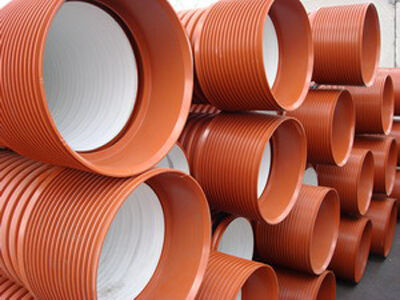
Such products can have a one- or two-layer structure, with the second option being especially common, combining a corrugated outer shell with a smooth inner surface. In this case, the corrugated structure reliably protects the pipe core from mechanical influences, in particular from soil pressure.

Typically, the diameter of a two-layer plastic pipe varies between 110-1200 mm, while the ring stiffness is 4 to 16 kN per square meter. m.
Like smooth products for external sewerage, corrugated elements are usually orange, red or brown, however, some manufacturers produce pipes of this type in other colors, for example, black.
Differences between ribbed and smooth products
In a number of indicators, corrugated pipes are superior to their smooth counterparts:
- they are many times more reliable, stronger, and more resistant to impacts;
- have increased flexibility and elasticity, which makes their laying easier, including in difficult conditions, for example, on changes in terrain;
- for the installation of corrugated products, virtually no fittings and other connecting elements are required, without which it is impossible to assemble a system of smooth pipes;
- corrugations have the ability to regulate the degree of rigidity by thickening some of the rings - this function may be needed when laying underground sewers;
- In case of leaks or other defects, a corrugated pipe is easier to repair than a smooth one.
It is easy to see that the consumer qualities of corrugated elements significantly exceed those of traditional analogues.
Application of various types of corrugated pipes
Products with a folded structure are widely used for various purposes:
- assemblies of drainage schemes;
- non-pressure rainwater drainage devices;
- installation of systems designed for drainage of industrial wastewater;
- non-pressure wiring underground sewerage schemes - household, general alloy;
- structures intended for agriculture.
Special types of plastic corrugated pipes, which have increased annular rigidity and frost resistance, are suitable for constructing passages under highly loaded highways.
Varieties by area of application
Considering the areas of use of pipes with a folded structure, the following categories can be distinguished.
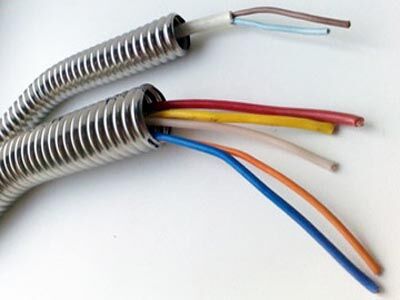
Used to protect wires and cables electrical installation corrugations. These products have average coefficients of elasticity and resistance to mechanical damage.
Single-layer corrugated pipes are lighter and more flexible. Such large-diameter elements are often used to protect gas pipelines, and compact products are often used for laying cables.
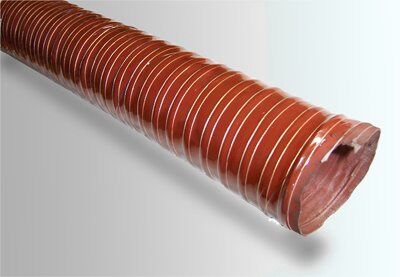
Double-layer corrugated hoses are characterized by good rigidity and strength, which allows them to withstand heavy loads. They are usually used for installing cables in difficult conditions, such as deep underground.
Corrugated pipes consisting of two layers. Such products have excellent strength/resistance to aggressive substances, which allows them to be used for laying sewers.
Classification of pipes by material
Most often, for the production of corrugated pipes of various modifications, such types of polymers as polyvinyl chloride (PVC) and modifications of polyethylene (PTN, HDPE) are used. Below we will look at both types of materials in detail:
Option #1: polyvinyl chloride products
One of the most common types of plastics, polyvinyl chloride, has the following qualities:
- high wear resistance coefficient;
- inertness to aggressive media, including alkalis, acids, mineral oils;
- frost resistance: even when completely frozen, cracks do not appear on the material;
- non-flammability - at +120°C PVC decomposes with the release of carbon monoxide.
The disadvantages of this material include sensitivity to high temperatures: polyvinyl chloride products begin to deform already at +60°C.
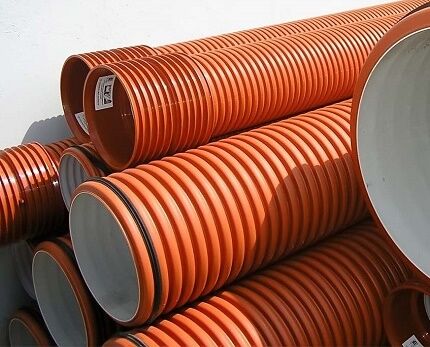
PVC pipes are considered universal: they can be used for laying industrial and private sewer systems. The high strength of such products, as well as their resistance to loads, allows them to be used for underground installation in the most stressful places, for example, under busy roads with large traffic flows.
There are two types of elements used for laying communications, namely:
- sewer corrugated pipes;
- products with probes used as protective structures for cable lines.
Depending on the strength indicator PVC pipes can be divided into the following categories.
Lungs. They have low resistance to loads. Mainly used for installation of external systems.
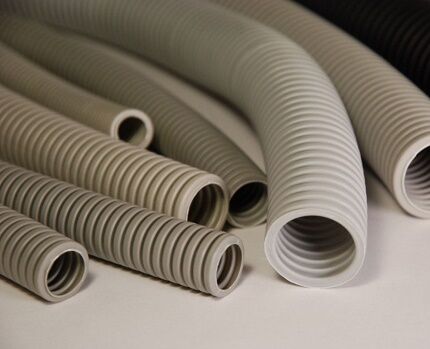
Heavy. The average mechanical strength allows such structures to be laid underground at a depth of up to 15 m.
Super heavy. They have the highest rigidity values, making them suitable for installing circuits in areas experiencing increased mechanical stress: heavy soils and areas under the roadway.
To optimally solve a specific problem, it is also important to take into account the pipe diameter and other qualities.
Option #2: polyethylene products
For the production of corrugated products, high-quality grades of polyethylene PE80, PE63, as well as polyethylene produced at low pressure (LDPE), are used.
The types of plastic used have the following properties:
- absolute resistance to alkalis and acids;
- excellent frost resistance (it should be noted that pipes made of this material stretch when frozen;
- good strength, durability;
- increased elasticity;
- environmentally friendly, since the polymer can be recycled.
The only drawback of polyethylene is its lack of resistance to elevated temperatures. However, there are some modifications of this polymer that can withstand the transportation of warm and even hot waste up to +80°C.
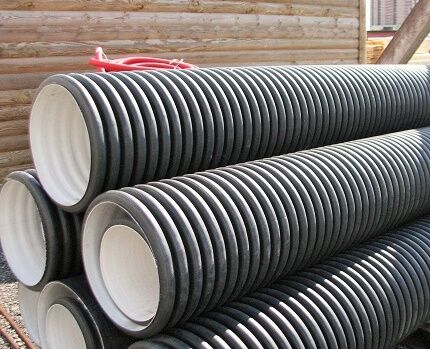
Corrugated polyethylene pipes have a two-layer structure. Such products are used for the installation of external sewage systems, and due to their high ring rigidity, they can be laid at a depth of up to 20 m.
The scope of application of polyethylene corrugated elements is very extensive, but most often they are used for laying sewer lines and organization of drainage systems. Soil drainage products are made from perforated materials, giving them an excellent balance of light weight and great strength.
Easy to install circuits are extremely efficient and can last for many years.
Another advantage of HDPE pipes is their increased elasticity: they can be installed without fittings, which greatly simplifies the process and reduces installation costs.
Comparison, application specifics and marking of PVC and HDPE pipes for external sewerage are described in this article.
Corrugated pipes: advantages and disadvantages
Regardless of the material from which corrugated products are made, they always have a number of important advantages:
- A light weight, thanks to which it is easier to store, transport, and stack such elements.
- Easy to install, the implementation of which does not require additional devices, equipment, or complex technology.
- Low cost all types of products.
- Long service life. A properly installed corrugated pipe system will last at least 50 years and even more.
- Smooth inner walls, which create an ideal surface that prevents the formation of congestion.
- Excellent performance: high coefficients of ring stiffness and strength allow the use of corrugated pipes for any purpose.
The disadvantages of such products include sensitivity to high temperatures. It is better not to use polymer corrugations for transporting hot waste or to use special modifications for this, for example, made from cross-linked polyethylene.
Plastic structures are often overly susceptible to ultraviolet radiation, so it is advisable to organize their storage under a canopy to avoid direct sunlight.

Standards for PVC and PNT products
There is a regulatory document regarding sewer pipes made of polyvinyl chloride, namely GOST 51613 “PVC pressure pipes,” which lists standards for products with a diameter of 10 to 315 mm, including those including socket elements with rubber seals.
At the same time, other types of pipes made from this material have long been used in construction, including corrugated structures for external sewerage. Similar products with a diameter of up to 630 mm are manufactured according to specifications (TU 2247-001-97341529-2008 and others).
There is also GOST 14254-96, which regulates the degree of protection for corrugated PVC pipes for sewerage.
In addition, different countries may have their own standards for polymer corrugations, such as EN 13476-3, adopted in the European Union.

Sewer pipeline maintenance
Due to their resistance to corrosion, resistance to frost and mechanical stress, systems made of corrugated structures have increased performance characteristics, which allows for a much shorter repair work. However, from time to time it is advisable to take measures to prevent the formation of blockages.
For this purpose, two methods of cleaning pipes are used:
- Dry cleaning, based on the use of active drugs that are introduced into the sewerage system.
- Hydrodynamic cleaning, which is carried out using a special tool that allows you to load steam or water under high pressure into the pipeline.
The first option is usually used as a preventive measure, while the second, which has a stronger effect, can effectively remove blockages or mineral deposits that have already occurred.
Methods for connecting corrugated pipes
When installing the pipeline, it is important to follow the following instructions.
It is advisable to carry out all work in spring or summer at air temperatures above 15°C. Before starting installation, it is important to carefully inspect the products to ensure that there are no visual defects, as well as compliance with the dimensions provided for in the projects.

The pipes are laid out along the side of the dug trench, so that their sockets are oriented towards the side opposite the slope.
Before installation, it is necessary to thoroughly clean the socket and the smooth end of the element, removing dust and dirt.

When connecting structures with sockets, rubber seals must be used.To do this, the ring is inserted into the groove on the second turn of the corrugation, and it should be ensured that the profile of the seal is oriented in the opposite direction from the direction of insertion of the element into the socket.
In some cases, instead of a socket connection, butt welding of products is used, which is carried out in accordance with GOST 16310-80. The process is similar to the connection of conventional polymer pipes using welding machines the same type.
To do this, you need to heat the end part of the pipe until the polymer begins to melt. Then it is enough to connect the elements by applying a certain pressure. After the structure has completely cooled, a monolithic seam will be visible on the plastic surface.
To get a good result, it is important when choosing a welding mode to take into account the diameter of the parts being welded, as well as the wall thickness of the components.
For connections of dissimilar materialsFor example, plastic corrugated pipes with products made of cast iron, asbestos cement, steel, reinforced concrete and other types of material usually use special devices - flanges or couplings.
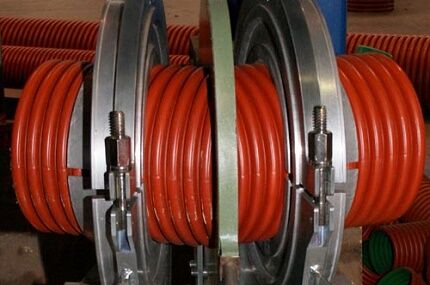
A more complex option that ensures the tightness of a structure consisting of several elements is the use of a coupling with a sealing ring, which is installed in the groove of the corrugated pipe.
It is important to fulfill the following condition:
- if the diameter of the product is 250-1200 mm, it is inserted into the first groove of the corrugation;
- if the channel cross-section is 125-200 mm, then in the second.
When installing the ring, it is important to ensure that its profile is directed in the direction opposite to the end of the pipe.
Domestic and foreign manufacturing companies
Corrugated products are produced by many enterprises. As an example, we will name just a few of them.
Popular Russian companies
Russian manufacturers produce a wide range of corrugated products for pipeline construction. Buyers have pipes of different diameters and connecting fittings for them at their disposal.
POLITEK
The domestic company, founded in 1999, has production complexes in Tula and Odintsovo (Moscow region), where modern imported equipment is installed.
In the production of products, innovative technologies are used to produce products of European quality. Much attention is paid to the quality control system: each batch is necessarily tested in factory laboratories.
The company's product range includes a variety of polymer products, including two-layer corrugated pipes of various sizes intended for laying external sewerage and cables.
POLYPLASTIC
The largest transnational company, whose headquarters is located in Moscow, and divisions in a number of CIS countries (Russia, Kazakhstan, Belarus).
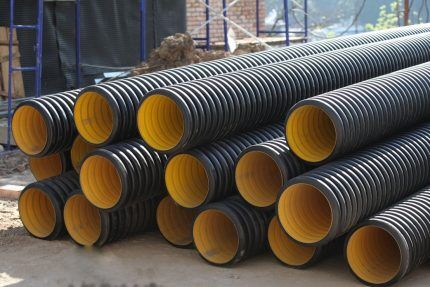
The company, which began its activities in 1991, offers a huge range of pipes made from different types of polymers. The products in the catalog differ not only in size, but also in consumer qualities, as well as in internal structure, which allows customers to choose the best option for a particular purpose.
For the installation of external sewerage, the company offers a line Corsis, including polyethylene products with a diameter from 200 to 3000 mm. The choice of options is quite wide: two-layer corrugated pipes of different sizes, multi-layer reinforced options, spiral elements.
NASAHORN
One of the most reputable domestic companies, operating on the market of our country since 2004. The company produces various types of plastic pipes for internal/external sewerage, including corrugated products (single-layer, double-layer).
In their production, advanced technologies and high-quality raw materials are used, which allows the manufacturer to provide a 50-year guarantee on all types of products.
Pipes NASAHORN can be purchased in many cities of Russia, as well as in a number of CIS countries.The company is constantly improving its range, offering consumers more and more new options for polymer products.
Well-known foreign companies
Products from foreign companies are presented on the Russian market. You can buy inexpensive products and products from the highest price segment.
OSTENDORF
German concern Ostendorf Kunststoffe was created in 1973 to produce polypropylene pipes and fittings, which quickly burst into the European markets.
The company quickly took a leading position, which it has not lost to this day, remaining a leading supplier of polymer products in Germany, as well as supplying products to many countries around the world.
In 2011, the company opened a plant Ostendorf Rus, operating in Yegoryevsk, Moscow region. The entire range of products is manufactured here using the latest German equipment from imported raw materials under strict quality control carried out by specialists from Germany.
The company produces pipes and components for the installation of external sewerage, which are made from a particularly hard type of polyvinyl chloride. Multilayer products are of the highest quality, which allows them to be used under any conditions
WAVIN
The Dutch company, founded in 1955, was one of the first in Europe to begin producing sewer and water supply polymer pipes. Currently, its products are supplied to many European countries.
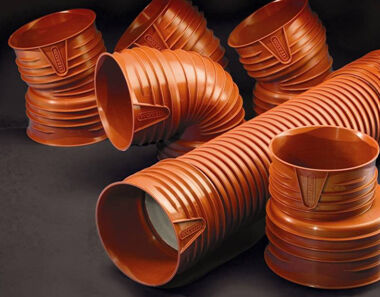
For the installation of external sewerage, the company’s specialists have developed an extremely reliable pipe system X-Stream, having a double wall with high ring rigidity (SN8). The products have different diameters (100-800 mm) and fully comply with the standards adopted in Europe.
In addition to corrugated pipes, the line also includes various options for fittings that have a special socket shape, which allows installation without any gluing.
FRANKISCHE
A German family company founded more than a century ago, in 1906. The assortment includes products made of polymers and metals needed in various areas of the national economy: in civil and industrial construction, for laying highways, etc.
The company's products are well known both in Germany and in a number of European countries.
An important place in the catalog is occupied by corrugated products intended for the installation of wastewater or storm water drainage systems. Options are offered that have two-layer walls with different ring stiffness values (SN16, SN8).
The offered products provide complete tightness, they are easy to assemble, reliable, and easy to operate.
Conclusions and useful video on the topic
In the video below you can clearly see the process of connecting double-layer corrugated pipes on site:
Corrugated pipes combine many advantages: ease of installation, resistance to aggressive materials, mechanical stress, and low temperatures. With careful selection of products and correct installation, sewer systems created from these elements will serve for a long time and reliably.
Do you have experience using corrugated pipes for the installation of external sewerage? Or still have questions on the topic? Please share your opinion and leave comments - the contact block is located below.




When the question arose about which pipes to use for sewerage in a new private house, we dug through the entire Internet. We consulted with a specialist contractor and agreed that it was better to use a corrugated pipe designed for these purposes. What captivated me was that they are lightweight, durable, fairly cheap, and easy to install. Due to their smoothness, they prevent the formation of congestion.
Corrugated pipes, of course, have more advantages over conventional smooth pipes: installation is much easier and this material is more reliable in operation, better resistant to the negative influences of the external environment. I worked with the German Frankish (FRÄNKISCHE), the quality is high, but they don’t have it any other way. However, our Polyplastic is no worse, and even more profitable in cost. Polymers last a long time and are undemanding in maintenance.